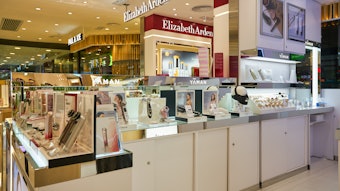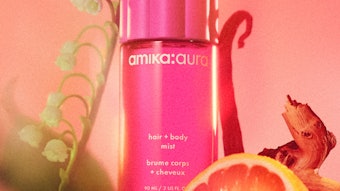
- An emotional engagement between consumers and a fragrance is key to successful launches and ongoing sales.
- Declining sales in the past decade can be linked to the decline in “easy-to-wear” fragrances.
- In order to thrive, a fundamental change in the current method of fragrance creation and marketing is necessary.
“I strongly believe, and I am sure all the perfumers present today will agree, that by using our beautiful palette of ingredients to its full potential, we can create quality fragrances that have character and signature, are diffusive and easy for the consumer to wear,” said Firmenich master perfumer Harry Fremont earlier this year as he accepted the 2010 FiFi Award for Perfume Extraordinaire of the Year on behalf of himself, his colleagues and his company for their work on Tom Ford Grey Vetiver (Tom Ford Beauty/Estée Lauder Co.). The award recognizes excellence in fragrance creation and the olfactory vision of the perfumer, focusing on craftsmanship, signature, creativity and quality. Fremont closed his acceptance by saying, “This standard of quality creates more passion, emotion and attraction for the fragrance itself, key elements for repeat purchase and perennial success.” In a recent interview, Fremont highlighted these key points in discussing the creation of Tom Ford Grey Vetiver and 2010 FiFi Fragrance Hall of Fame winner ck one (Calvin Klein Cosmetics/Coty Prestige). Time and again, the perfumer returned to his keys for successful scents: quality of materials, wearability, character and signature.
Genderless Breakthrough
In 1993, Firmenich’s burgeoning New York perfumery studio received a brief from Calvin Klein for a genderless fragrance. “Calvin Klein was onto something hot at that moment,” says Fremont. “We thought it could be really groundbreaking—it was incredible.” The perfumer remembers the brief being particularly detailed. “Calvin Klein had done a lot of research and focus groups with Generation X: its habits, what it was wearing, what it wanted and how it was communicating.” From this research emerged the idea of a “shared fragrance.” Firmenich perfumer Alberto Morillas’ fragrance was the original candidate during the development process, which featured developer Ann Gottlieb. “It was really the idea of finding something that would be masculine enough to be worn by a man, but also something that could be worn by a woman,” Fremont remembers.
In all, the development process took about eight months and was marked by the then-novel concept of perfumer teams. Building on the candidate formulated by Morillas, Fremont joined the team to revise the final fragrance and provide a fresh set of eyes. “We tried to do that early in the game because we felt that it’s very important to have the right idea, but it’s also very important to finish the idea,” says Fremont who continues to regularly partner with other Firmenich perfumers.
“Sometimes, when a project is complicated, it’s not possible to finish [a fragrance by oneself],” he continues. “Sometimes you get to a point where you have tunnel vision and you don’t see what can be done. You lose your perspective a little bit. There’s a lot of pressure. Every day, as perfumers, we have an idea and then we are fixing the problems of the idea to make it right.” Meanwhile, client feedback drives further revisions. This is an easy process, Fremont explains, when the feedback is specific—say, an undesirable green note. In those cases, the perfumer can look at the formula and cut the green note. In other cases, the feedback is more abstract and difficult to address. “That’s when you need to ask another perfumer to [add a new perspective],” says Fremont.
In the case of ck one, Fremont says, the citrus note was particularly challenging. “People were afraid of citrus in the United States because they associated it with dish washing liquids and things like that.” Moreover, a citrus that was too sweet or candylike would have been similarly off-putting for American consumers. “The trick was to make the citrus refined,” says Fremont. “I think there is a flow in the fragrance that is very important. It is part of why the fragrance was successful and is still successful today.
The scent was among the fragrances that led to a broader acceptance of citrus in the United States. Fremont explains that this fresh citrus, combined with a green tea effect, led to ck one’s signature freshness with an underlying sensuality. “It has this dual [effect],” he says. “It’s fresh, but it’s long-lasting; it has a floral heart. It’s also very fluid. It is a fragrance that has character, but is easy to wear, that leaves a long-lasting sensuality on skin, but is still a bit fresh and moist. I’m not surprised that it worked very well for men and women.
“I don’t think ck one is an extreme fragrance. It was more about the quality of the materials that contributed to a groundbreaking construction and freshness, warmth and fluidity—that’s what made the difference. I think it’s also a combination of what’s important for people: to have the feeling that a fragrance is long-lasting—not in a very invasive way, but in a very comfortable way. ck one gives you this feeling when you wear it, and you get addicted to this effect.”
The scent was among the Firmenich New York group’s first best-selling signature fragrances—along with Polo Sport and Estée Lauder Pleasures—which helped reinforce its presence in the U.S., the importance of its creativity and palette of captive materials. “I still have wonderful memories of it,” says Fremont. “It was such an emotion when we won this fragrance. We had goose bumps. You have some fragrances where, when the development starts, you can feel that it will be big but we never before had something like that. Fragrance is always a reflection of our time. ck one didn’t age so much in a way because it has character, and it’s easy to wear. It’s fresh, it’s fluid, it’s musky-sensual; those are still key qualities today.”
Today’s Palette: Dream Materials
While never discounting the importance of the perfumer’s creativity, Fremont says, “Very often when you have a new [hit] fragrance on the market, it’s because you have a new groundbreaking material in it. One example is Light Blue for women,” he explains. “Olivier Cresp, master perfumer at Firmenich in Paris, was very creative with this fragrance, but he also used materials that had never been used in that quantity, like a woody note from Firmenich. “Today we have a fantastic palette of materials—natural products and molecules,” Fremont continues. “For me that’s one of the beautiful things. When I started in this business I thought, ‘Oh, I missed everything; everything is done already.’ I believe today we have the best palette of materials a perfumer ever had. Consider that we have natural products that are extracted in a way that is much gentler and respects much more the quality of the products, and the huge palette of molecules that are incredible in all categories of materials—fruity, musk, floral, woods. And we have materials through headspace technology. That’s a huge advantage over perfumers who were working 10 or 20 years ago. What we have today is groundbreaking compared to what we had before—even if we lose some material for safety reasons, we still have the best palette today.”
As an example, Fremont notes an extraction process Firmenich employed to produce a new type of vetiver oil that Fremont calls “the dream material” and forms the basis for the FiFi’s award-winning Tom Ford Grey Vetiver. “It’s the vetiver you have in your mind, that you never smelled before because [traditional] extraction doesn’t get it right.”
The typical method of vetiver extraction often yields an oil that tends to have a musty, potatolike smell.
“I personally was always obsessed with vetiver,” he continues. “It’s the roots that are extracted. When you smell it, you smell the earth. It’s like the smell of fire. It’s one of those primal things that are embedded in people’s minds.” For some time, Fremont had hoped to convince clients to make a high-quality vetiver fragrance, but consistently met resistance due to cost, which can rise 200–300% above typical price thresholds. “To have a fragrance smell of vetiver you have to use a certain amount of it,” says the perfumer. “The problem we have today is we all use these beautiful [natural] materials, but we use them in a homeopathic dosage because the money that is allowed to us to work on a project is just not enough. With this fragrance, working with Karyn Khoury, [senior vice president, corporate fragrance development worldwide for The Estée Lauder Companies], I had license to use this palette to the full potential. I believe it makes a huge difference.” And so, using his dream vetiver, a “very good” clary sage and a captive woody molecule, Fremont formulated Tom Ford Grey Vetiver. The result, he says, is a new, elegant vetiver fragrance, which met designer Tom Ford’s “perfect sense of taste.” “He wanted a vetiver that really smelled like vetiver,” says Fremont. “He wanted to create a vetiver for sleek elegance. This fragrance is about more than craftsmanship—it’s about quality. Tom Ford has a sense of precision and style, and he was able to translate that in the fragrance he wanted.”
Quality and the Consumer
“It’s very shocking for me today that, while we know that quality for every consumer product is important, it is not always considered in fragrance,” says Fremont. “You have the creativity on one side, but you also need good materials. The reality is [that] the cost of the oil in the fragrance is small compared to the cost of the advertising, the bottle, the packaging, etc. I’m sure if we were to push back some of this money into the juice itself, it would make a huge difference.”
In addition, Fremont believes that high-quality natural ingredients can build story, ethics and sustainability into a fragrance launch. “I think what consumers are missing is quality, but also an emotional link to what’s in the bottle. Most fragrance launches don’t engage the consumer emotionally. Now I think I see a trend of natural materials linked with the local community producing them. That’s going to take naturals to a place that is much more [impactful]. For the consumer, it’s important that, by buying this product, they are doing good for a part of the world. To touch people it has to be grounded and true. With authenticity we’re going back to quality.
“If you have license to use certain materials in bigger quantities we can go much further,” Fremont continues. “Because you have the best combination between the richness of the naturals and the amazing qualities of the molecules—diffusion and long-lasting and character—you can have fragrances that are creative and new.”
The point isn’t that more expensive ingredients automatically guarantee a great fragrance, but it undeniably helps. Due to the general loss of authenticity and quality in perfume launches, Fremont says, “Today we see people walking away from fragrance.”
This “lapsed user” was the subject of forthcoming research conducted by Firmenich. “We lost consumers every year for the past 10 years—especially in [the U.S.],” says Fremont. In the course of this research, one thing became clear, “The lack of quality in the fragrances created in the past 10 or 15 years is partly responsible for this phenomenon. When you look at the lapsed user study, what you see is that the market is separated into the heavy user, who is buying lots of fragrance, wearing it every day; the normal user, who is wearing fragrance, but not every day; and those who are not wearing fragrance anymore.” The non-heavy fragrance users make up a significant portion of the population.
Fremont traces these phenomena in part to the decline in what he sees as easy-to-wear fragrances. “I think there is a relationship between easy-to-wear fragrances and quality,” he says, “because when you don’t have the quality in the fragrance [formulators may] try to compensate by using materials that are powerful—sometimes too strong—like vanilla or some sandalwood note; very invasive products. The non-heavy user, I believe, is sensitive to that.” And so, even as fragrances employ “invasive” materials for diffusion, long-lastingness, power and signature, they are losing audience. “Non-heavy users are people who think maybe it’s not appropriate to wear fragrance at the office,” says Fremont. “Maybe if the fragrance is too strong people are going to comment about you, and you are not going to blend in. If we were making more quality fragrances, they’d be much happier to wear fragrance. It’s like wearing a suit. A suit, when it’s well done, fits perfectly; you are comfortable, it’s elegant and you are not self-conscious. I think fragrance is the same. You will find that many people are scared of sending the wrong message when they wear fragrance.”
Fremont says it was easy to launch fragrances of unexceptional quality when the perfumery industry was booming. Today, however, the market has become fragmented, with the top 10 fragrances accounting for fewer than 50% of the market. “This crisis in [the past few years] really emphasized existing problems. We didn’t change the business model. We need to change the way we operate and create fragrances to make this industry thrive and be as powerful as it was 15 years ago.” The recent crisis and overall consumer trends show that a different mindset is necessary. “I’m hoping that people are going to realize that they need to go back to quality and to get the perfumer to use the materials to their full potential. With most fragrance launches today, consumers don’t have a good experience because they are missing an addictive quality. Addictive quality isn’t something that has to be strong and in-your-face. Addictive quality can be very subtle and almost subliminal.
“The biggest successes on the market are all linked by quality,” Fremont continues. “If you take Beautiful by Estée Lauder, for a very long time it was the most expensive fragrance oil and it stayed at number one [for years], and it’s still a top-selling fragrance. I believe that at the end of the day consumers see the quality of the fragrance. Fragrance is such an intimate product, something you put on your skin; you wear a fragrance the same way you wear a dress. If you make a product that [consumers] like, they will buy it again and again. To do that, quality is key.”
This feature was originally published in the September 2010 issue of Perfumer & Flavorist magazine. The P&F version, “Comparing Notes: Quality is Key,” contains additional technical information on specific ingredients.
Jeb Gleason-Allured is the editor of Perfumer & Flavorist magazine.







![According to the Personal Care Products Council, 'Between 1990 and 2022, the [U.S.] personal care products industry generated a trade surplus every year, reaching $2.6 billion in 2022...'](https://img.gcimagazine.com/mindful/allured/workspaces/default/uploads/2025/08/adobestock-353393403.MryFiCWzOJ.jpg?auto=format%2Ccompress&fit=crop&h=191&q=70&w=340)


